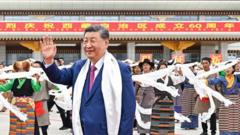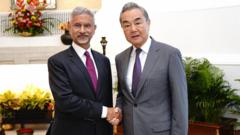Nike's Air Jordan 1, known as a symbol of American basketball culture, is at the risk of higher prices as President Donald Trump's tariff initiatives target Asian production—home to most of Nike's manufacturing. Following the announcement of the potential tariffs, Nike's stocks saw a significant drop of 14%, reflecting fears about the economic repercussions.
**Nike's Iconic Trainers: The Impact of Tariffs on Prices and Production**

**Nike's Iconic Trainers: The Impact of Tariffs on Prices and Production**
As the U.S. considers imposing tariffs on imports, Nike faces pressure to adjust its pricing and production strategies, impacting consumers and the sneaker market.
The extent of price changes for Nike's trainers is contingent upon corporate strategy regarding the potential tariff-induced cost increases. Current estimates predict a rise between 10% to 12% on imports from Vietnam, which accounts for a significant portion of Nike's production. Industry analysts assert that with increased tariffs, price hikes may be virtually unavoidable; however, selling prices must be balanced against the highly competitive market, where excessive increases could diminish consumer demand.
In addition to contemplating a price increase, Nike may consider modifications in production techniques to alleviate costs, such as using less advanced materials or extending the period between design iterations. Analysts caution that further uncertainties surround these tariffs, as the negotiations between the U.S. and its trade partners may yield changing figures.
Nike's sales heavily rely on U.S. consumers, generating substantial revenue, but fluctuating tariffs on imports from China and Vietnam may force the company to reevaluate its supply chain and pricing strategies. Though there's speculation that increased manufacturing within the U.S. could offset tariffs, experts note the complexity of footwear production would render such a strategy challenging and time-consuming.
With Nike's market position as a leading brand, its response to tariffs could set a precedent for wider industry trends. As the situation evolves, stakeholders remain on alert regarding how this tariff landscape will reshape the iconic brand's pricing and production strategies.
In conclusion, Nike's reaction to tariffs will not only influence its standing in the market but also provide insights into the broader challenges faced by American brands reliant on Asian manufacturing.
In addition to contemplating a price increase, Nike may consider modifications in production techniques to alleviate costs, such as using less advanced materials or extending the period between design iterations. Analysts caution that further uncertainties surround these tariffs, as the negotiations between the U.S. and its trade partners may yield changing figures.
Nike's sales heavily rely on U.S. consumers, generating substantial revenue, but fluctuating tariffs on imports from China and Vietnam may force the company to reevaluate its supply chain and pricing strategies. Though there's speculation that increased manufacturing within the U.S. could offset tariffs, experts note the complexity of footwear production would render such a strategy challenging and time-consuming.
With Nike's market position as a leading brand, its response to tariffs could set a precedent for wider industry trends. As the situation evolves, stakeholders remain on alert regarding how this tariff landscape will reshape the iconic brand's pricing and production strategies.
In conclusion, Nike's reaction to tariffs will not only influence its standing in the market but also provide insights into the broader challenges faced by American brands reliant on Asian manufacturing.


















